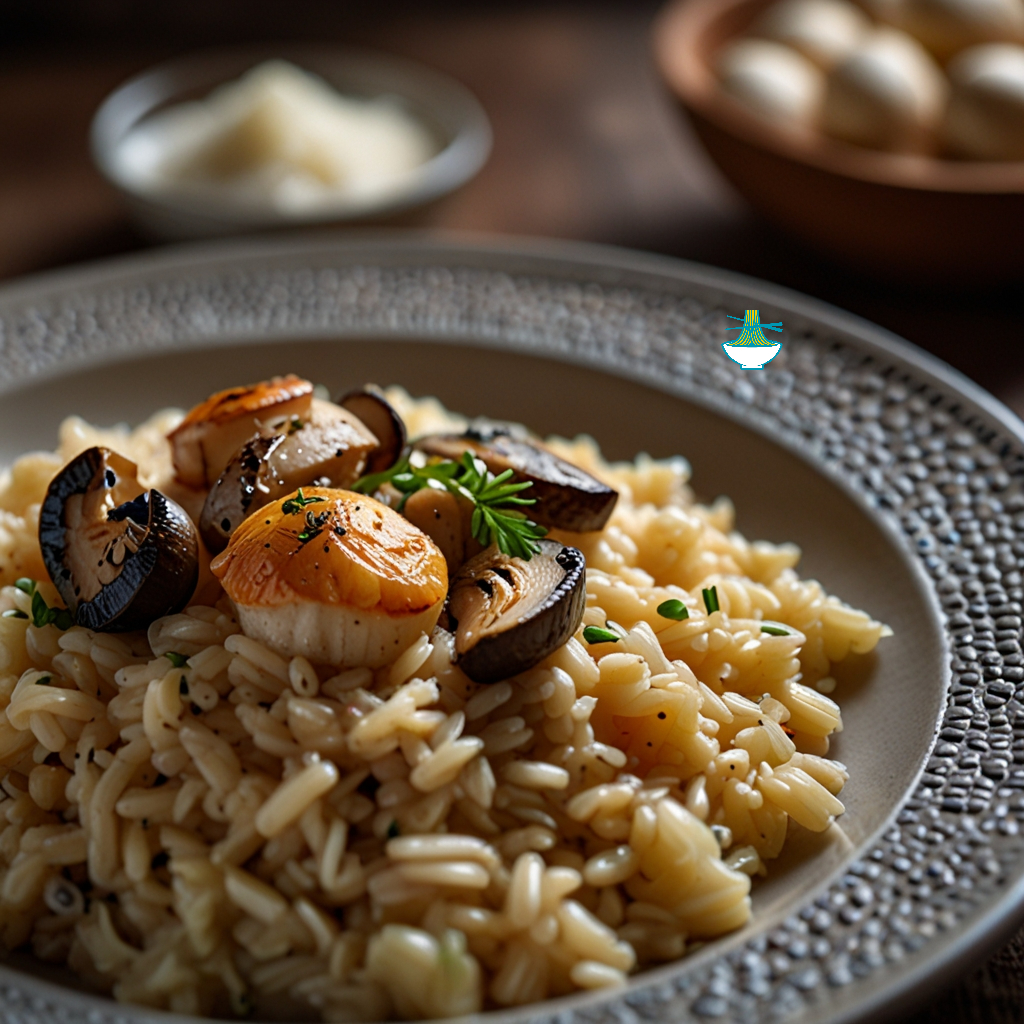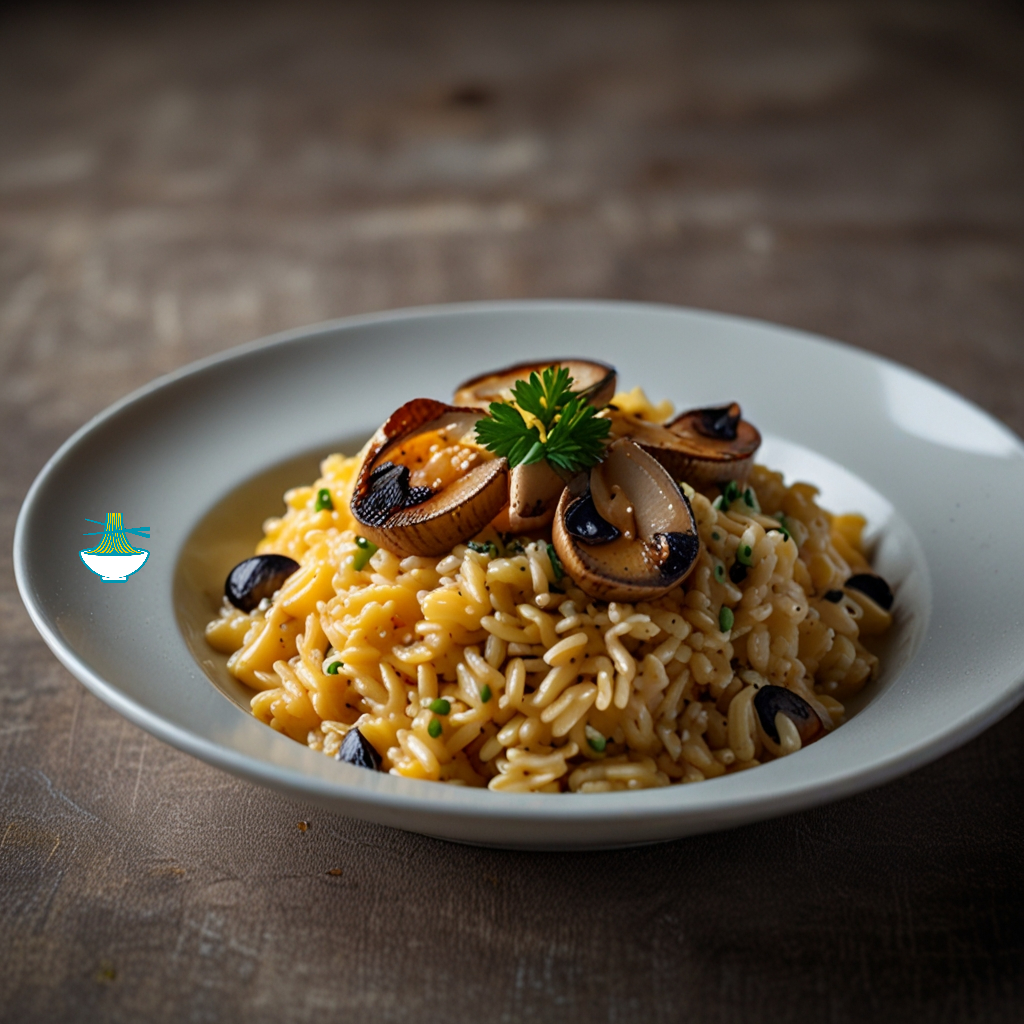Risotto is a classic Italian dish known for its creamy texture and rich flavors. It originated in Northern Italy, particularly in the regions of Lombardy and Piedmont, where rice cultivation is prominent. The dish is made by slowly cooking Arborio, Carnaroli, or Vialone Nano rice in broth until it reaches a creamy consistency. The key to a perfect risotto lies in the gradual addition of hot broth, which allows the rice to release its starches, creating a velvety sauce.
Historically, risotto dates back to the 14th century, with early mentions of a similar dish called "riso al salto" in Milanese cookbooks. However, it wasn't until the 19th century that risotto gained popularity throughout Italy and eventually internationally. Today, risotto is enjoyed in various forms, often flavored with ingredients such as mushrooms, seafood like shrimp or scallops, or the luxurious saffron, which gives the dish its distinct yellow hue and delicate aroma.
Ingredients:
- 1 cup Arborio rice
- 4 cups chicken or vegetable broth
- 1/2 cup dry white wine (optional)
- 1/2 onion, finely chopped
- 2 cloves garlic, minced
- 2 tablespoons olive oil
- 1/2 cup grated Parmesan cheese
- Salt and pepper to taste
- Optional: mushrooms, seafood (like shrimp or scallops), saffron threads
Method:
1. In a saucepan, heat the broth until simmering, then reduce the heat to keep it warm.
2. In a separate large pan, heat olive oil over medium heat. Add onions and garlic, sauté until translucent.
3. Add Arborio rice to the pan, stirring constantly until the rice is coated with oil and slightly translucent.
4. Optional: Pour in the white wine and stir until absorbed.
5. Begin adding warm broth to the rice, one ladleful at a time, stirring frequently. Allow each addition to be absorbed before adding more broth.
6. Continue this process until the rice is creamy and cooked al dente, about 18-20 minutes.
7. If using, add mushrooms, seafood, or saffron during the last few minutes of cooking.
8. Remove from heat, stir in grated Parmesan cheese, and season with salt and pepper.
9. Let it rest for a few minutes before serving. Garnish with additional Parmesan if desired.
Nutrition Value:
1. Arborio Rice:
- Calories: Approximately 220 calories per cup
- Carbohydrates: Around 45-50 grams per cup
- Protein: About 4-5 grams per cup
- Fat: Minimal, less than 1 gram per cup
- Sodium: Low, typically less than 10 milligrams per cup
- Cholesterol: None
- Vitamins and minerals: Contains small amounts of B vitamins like niacin and thiamine, as well as minerals like magnesium and phosphorus.
- Nutritional benefits: Arborio rice provides energy from carbohydrates and some essential nutrients, although it's not particularly rich in vitamins or minerals.
2. Chicken or Vegetable Broth:
- The nutritional content can vary depending on the brand or homemade recipe. Generally:
- Calories: Around 10-20 calories per cup
- Carbohydrates: Minimal, usually less than 1 gram per cup
- Protein: Varies, but can provide a few grams per cup
- Fat: Low, typically less than 1 gram per cup
- Sodium: Can be moderate to high, depending on the type of broth
- Cholesterol: If homemade, usually minimal or none
- Vitamins and minerals: Depending on the ingredients, it can provide electrolytes like potassium, some B vitamins, and minerals like calcium and iron.
- Nutritional benefits: Broth adds flavor to the risotto and can contribute some essential nutrients, especially if it's homemade with wholesome ingredients.
3. Dry White Wine (optional):
- Calories: Approximately 120-150 calories per 5-ounce serving
- Carbohydrates: Around 3-5 grams per serving
- Protein: None to minimal
- Fat: None
- Sodium: Low, typically less than 10 milligrams per serving
- Cholesterol: None
- Vitamins and minerals: Contains small amounts of potassium, phosphorus, and some antioxidants like resveratrol.
- Nutritional benefits: Wine can add flavor complexity to the dish, but its nutritional contribution is minimal.
4. Onion:
- Calories: Approximately 40-50 calories per 1/2 cup chopped
- Carbohydrates: Around 10-12 grams per 1/2 cup
- Protein: About 1 gram per 1/2 cup
- Fat: None
- Sodium: Very low, typically less than 5 milligrams per 1/2 cup
- Cholesterol: None
- Vitamins and minerals: Rich in vitamin C, vitamin B6, folate, potassium, and antioxidants like quercetin.
- Nutritional benefits: Onions provide flavor, texture, and essential nutrients without adding many calories.
5. Garlic:
- Calories: Approximately 5-10 calories per clove
- Carbohydrates: Around 1-2 grams per clove
- Protein: Minimal
- Fat: None
- Sodium: Very low, typically less than 1 milligram per clove
- Cholesterol: None
- Vitamins and minerals: High in vitamin C, vitamin B6, manganese, and antioxidants like allicin.
- Nutritional benefits: Garlic adds a distinctive flavor and provides health-promoting compounds.
6. Olive Oil:
- Calories: Approximately 120-130 calories per tablespoon
- Carbohydrates: None
- Protein: None
- Fat: About 14 grams per tablespoon, mostly monounsaturated fats
- Sodium: Very low, typically less than 2 milligrams per tablespoon
- Cholesterol: None
- Vitamins and minerals: Contains vitamin E, vitamin K, and antioxidants like polyphenols.
- Nutritional benefits: Olive oil adds richness and healthy fats to the dish, beneficial for heart health and inflammation.
7. Parmesan Cheese:
- Calories: Approximately 110-120 calories per 1/4 cup grated
- Carbohydrates: Less than 1 gram per 1/4 cup
- Protein: Around 10 grams per 1/4 cup
- Fat: About 7-8 grams per 1/4 cup
- Sodium: Varies but can be moderate to high
- Cholesterol: Around 20-25 milligrams per 1/4 cup
- Vitamins and minerals: Rich in calcium, phosphorus, and vitamin A.
- Nutritional benefits: Parmesan adds a savory, umami flavor and contributes protein and calcium to the dish.
8. Salt and Pepper:
- Calories: None
- Carbohydrates: None
- Protein: None
- Fat: None
- Sodium: Varies depending on usage
- Cholesterol: None
- Vitamins and minerals: Minimal, primarily sodium for salt.
- Nutritional benefits: Adds flavor but should be used in moderation due to sodium content.
9. Optional Ingredients (Mushrooms, Seafood, Saffron):
- Each optional ingredient will have its own nutritional profile.
- Mushrooms: Low in calories, fat-free, and a good source of vitamins and minerals, especially B vitamins, selenium, and potassium.
- Seafood (Shrimp or Scallops): Low in calories, high in protein, and a good source of omega-3 fatty acids, vitamins B12 and D, and minerals like selenium and zinc.
- Saffron Threads: Very low in calories, adds color and a subtle flavor, and contains antioxidants.
Including these optional ingredients can enhance the flavor and nutritional diversity of the risotto, providing additional vitamins, minerals, and healthy fats or proteins.


Comments